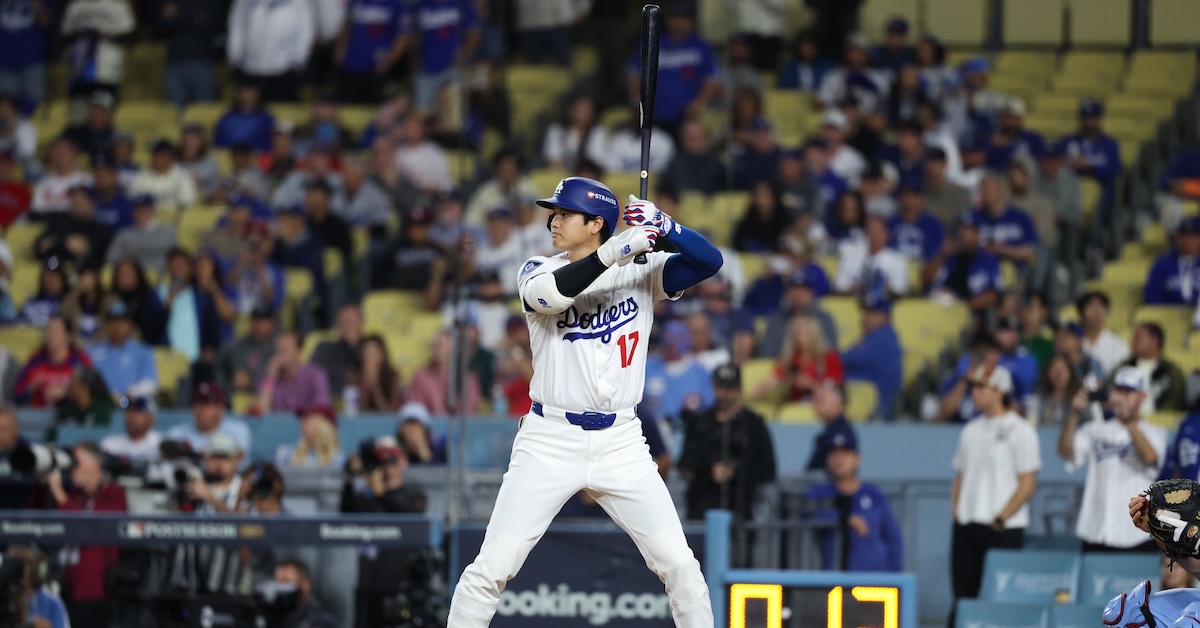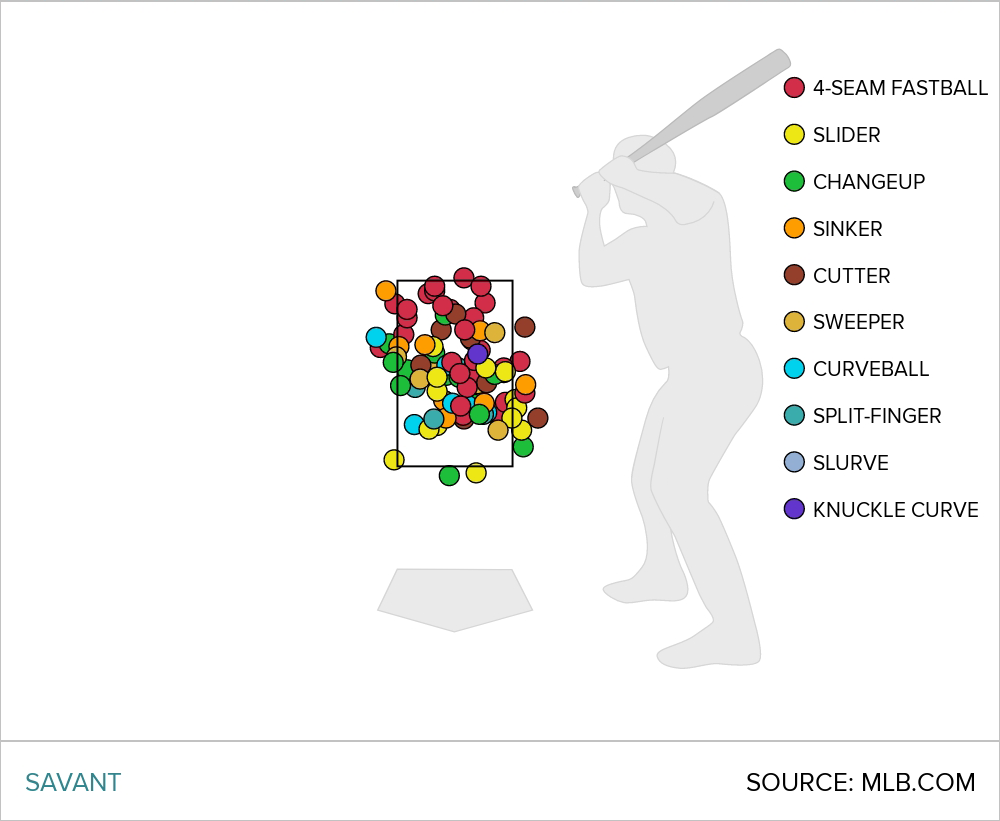The Alarming Stillness of Shohei Ohtani

Sometimes Shohei Ohtani pulls his elbows gently to the left. He stands there at the plate still as a statue, the bat way out in front of him and his arms spread wide like they’re wrapped around an invisible trash can lid. Sometimes, every once in a while, he’ll gently rock the whole package – the elbows, the invisible trash can lid, the handle of the bat, his broad shoulders – to the left, back toward the catcher, the bat head dipping to describe a quiet circle in the air. And then he rocks the whole package to the right again, just as gently, toward the pitcher. It’s a matter of an inch or two. It’s the only sign that he’s human.
Once he’s settled into his batting stance, that little reset, rocking back and then forward like he’s absorbing a wave that no one else on the field is attuned enough to feel, is the only movement Ohtani will make. He doesn’t have a bat waggle. He doesn’t flex and unflex his fingers like Max Muncy. He doesn’t flare his back elbow like Bobby Witt Jr. He doesn’t rock his shoulders like Alex Bregman, lean back like Rowdy Tellez, twitch his hips like Juan Soto, fire his back knee toward the pitcher like Marcus Semien, or test the dirt with his front foot like Cal Raleigh. He’s a mountain, unapproachable, indecipherable.
He gives no outward sign that he has any need of staying loose. Loose is the last thing he looks like. Try holding a baseball bat the way Ohtani holds it, up at eye level, way out in front of you, almost perfectly vertical with your elbows out. It won’t take long for your arms to get tired. Try sinking into a slight crouch with your feet spread so wide you could slide a yardstick between them with room to spare. Don’t let yourself move a muscle. Keep your heels rooted to the ground. You’ll start to feel like you’re stuck in cement. That’s how Ohtani prepares for the pitch. He remains taut, indifferent to the game that breathes all around him.
It must be so demoralizing for opposing pitchers. They need those tiny signs that Ohtani is human and not something greater. At 6-foot-3, he’ll be the second-tallest player to dig into the batter’s box during the World Series, and he’s built like a Transformer. He’s the kind of being who would have, in earlier times, been immortalized and eventually deified as his stories got handed down from generation to generation. In this day and age where we can put a number on just about anything a player does on the ballfield, his feats have already transcended that quantification. And every time you see him emerge from the dugout, he’s locked into this trance. Staring deep into your soul. Looming.
The pitchers have read the scouting reports, but how much can they really help? It’s Shohei Ohtani. There’s no such thing as the right pitch type. He ran a .429 wOBA against fastballs and cutters, a .390 wOBA against changeups, a .435 wOBA against curves, and a .401 wOBA against sliders. When somebody’s hit all of these pitches below for extra bases, there’s no such thing as the right location either.

He’ll swing and miss. He’ll strike out. He’ll take an ugly swing. But none of that means you’re safe. Somehow that ugly, off-balance swing will elicit the loudest crack you’ve ever heard in your life. The ball will explode into the sky, and he’ll be jogging around the bases with an aw-shucks grin.
I first noticed this uncanny stillness early in the morning of March 19, as the season opener unfolded in the Tokyo Dome. “It’s unnerving how still Ohtani’s batting stance is,” I wrote in my notes. “Most players need to keep some sort of motion going just to stay springy and athletic. Ohtani is like a statue. Even in the on-deck circle, he just has his arms extended, elbow up, only relaxing into his stance once the pitcher has already started their delivery.” Having written about this, I watched for it all season long. I loved those shots of him in the on-deck circle the most. He’s every bit as intense when he’s not a part of the action. In Game 4 of the NLDS, Ohtani hit three home runs and went six scoreless innings. The highlights are tremendous, but you’ve seen them plenty of times already. The time in between all that action is every bit as riveting. Here’s a full minute of Ohtani standing in the batter’s box completely frozen, except for that occasional reset.
You’re on the mound at Rogers Centre for Game 1 of the World Series in front of tens of thousands of screaming fans. Andy Pages is at the plate. Against your better judgment, Ohtani, over in the on-deck circle, is at the front of your mind. You grip the ball in your glove, preparing yourself for the pitch, but you can’t help stealing a glance. His eyes are locked on you. His expression is neutral, almost impassive, like he’s seeing right through you. You pull your focus back to your target, but you know that he’s still watching. Even in the periphery, that stillness makes him stand out even more. He’s the only thing in the entire ballpark that isn’t moving. The rows and rows of fans are shouting and clapping and reaching for their phones. The billboards behind the plate are flashing. The umpire, catcher, and batter are all settling into their stances. And out of the corner of your eye, this monolith refuses to fit into the tableau, the negative space that keeps sucking you in.
And then he’s in the batter’s box. You know he’ll never break before you do. He’ll stay absolutely motionless until you’re already deep into your delivery, revealing nothing, unwilling to waste energy on anything that might distract him from your offering. He won’t even ease into a hitting position until you’ve already committed yourself, raised your knee up toward your chest and broken your hands. You know what can happen once he finally deigns to move. You’ve seen how effortlessly he becomes a killer. It’s not like he’s transfigured. There’s no shell that cracks to reveal the grace and fluidity and power of his swing. They’ve been there all along, suspended. And right as you’re straining to put everything you’ve got into the pitch, he relaxes, finally, for a moment, and explodes.
Davy Andrews is a Brooklyn-based musician and a writer at FanGraphs. He can be found on Bluesky @davyandrewsdavy.bsky.social.
An alternate version of this article could simply have been a dozen or so GIFs of Ohtani being still
Pretty sure the header pic is a gif.